Teakwood works brilliantly in your signature scent because of its complex molecular structure and versatile aromatic profile. You'll find its rich, earthy notes blend seamlessly with various complementary scents, from bright citrus to warm spices. It's incredibly adaptable across seasons – pair it with cinnamon in winter or light florals in summer. Your skin chemistry will enhance its sophisticated blend of natural compounds, creating a uniquely personal fragrance. There's much more to discover about this timeless aromatic treasure.
The Rich Heritage of Teakwood in Perfumery

While many fragrance ingredients come and go with passing trends, teakwood has maintained its status as a coveted perfume component for centuries.
When you're choosing a signature scent, you'll find that teakwood's enduring popularity stems from its sophisticated and distinctive aroma, deeply rooted in Southeast Asian heritage. Modern perfumers often pair it with allspice and leather to create compelling top notes.
You'll appreciate how this remarkable wood, particularly from the Tectona Grandis species, brings more than just durability to your fragrance.
Its rich, earthy notes have transcended cultural boundaries, finding their way from traditional incense practices to modern perfumery.
What makes teakwood particularly special in your signature scent is its ability to deliver a timeless appeal that's both grounding and refined, connecting you to centuries of aromatic tradition while remaining thoroughly contemporary.
Understanding Teakwood's Molecular Structure
When you explore teakwood's molecular structure, you'll find a complex array of compounds that create its distinctive aroma and durability. Your nose picks up scents from bioactive compounds like tannins, polyphenols, and terpenes, while essential oils contribute to teakwood's signature fragrance profile.
The wood's molecular composition changes as it ages, with young teakwood containing more 1,3-indandione, while older wood develops higher concentrations of tectoquinone and lapachol. Chemical analysis shows that acetone-isopropanol extraction yields the most efficient isolation of these aromatic compounds.
You'll discover that different parts of the molecular structure serve specific purposes – hydroxyl groups provide stability, carbonyl groups add complexity to the scent, and aromatic rings create that characteristic woody base note you've come to love in your perfume.
These compounds work together to give teakwood its unmistakable olfactory identity.
Essential Components That Define Teakwood
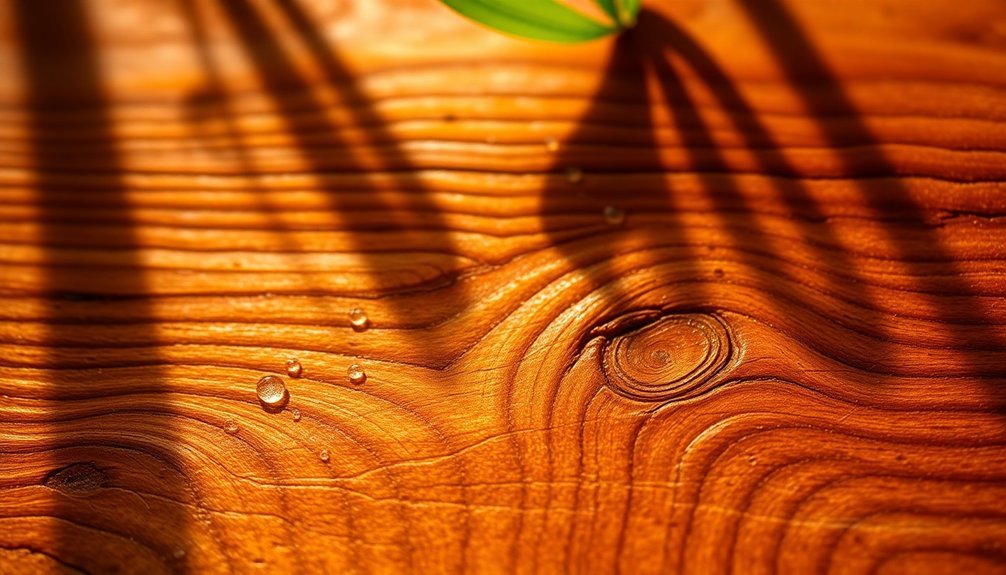
The distinctive essence of teakwood emerges from a rich tapestry of layered notes that work in harmony.
You'll find its character defined by deep woody foundations complemented by warm amber and exotic sandalwood. The middle notes bring life to your signature scent through delicate florals and aromatic spices, while tobacco leaf and lavender create an intriguing balance. This bold, masculine scent has become increasingly popular in modern fragrances.
- Base notes combine teakwood with leather, musk, and tobacco for a bold, sophisticated foundation.
- Middle notes feature jasmine, bergamot, and clove to add depth and complexity.
- Complementary scents like patchouli and cedarwood enhance the natural woody profile.
- The fusion of these components creates a versatile fragrance that's perfect for personal care products, from candles to beard oils.
Top Notes That Complement Teakwood
Building upon teakwood's rich foundational elements, top notes play an essential role in creating your signature scent's first impression. You'll find four distinct categories of top notes that can transform your teakwood fragrance into something uniquely yours.
| Opening Style | Key Notes |
|---|---|
| Bright & Fresh | Citrus, Bergamot, Fruity Accords |
| Spicy & Invigorating | Sichuan Pepper, Pink Pepper, Cinnamon |
| Floral & Herbal | Jasmine, Lavender, Geranium |
| Aromatic & Aquatic | Marine Notes, Green Elements, Bergamot-Pepper |
Whether you're drawn to the zesty burst of citrus, the warmth of spices, the softness of florals, or the freshness of aquatic notes, you'll find that these top notes work harmoniously with teakwood's character while adding their own distinctive personality to your signature scent.
Creating Depth With Base Note Combinations
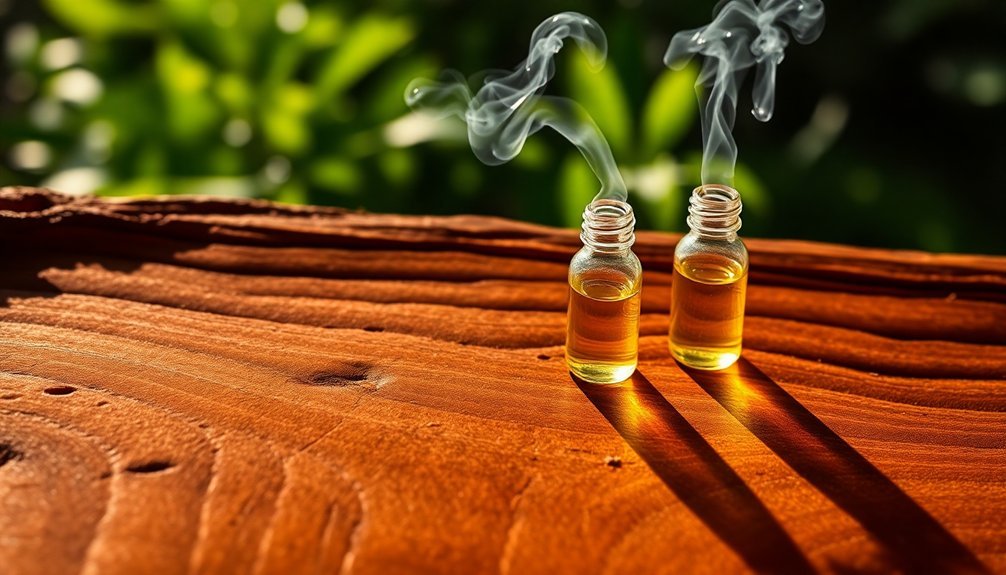
When you're building depth with teakwood in your signature scent, layering it with amber and musk creates a rich, multidimensional foundation.
You'll notice how amber's warmth softens teakwood's intensity while musk adds an earthy dimension that grounds the entire composition.
These base note combinations work together to enhance teakwood's natural woodiness while ensuring your fragrance maintains its character throughout its wear time.
Layering Woods With Amber
Creating depth in your signature scent requires mastering the delicate balance between woods and amber base notes. Teakwood's smooth, creamy profile makes it an ideal foundation, offering warmth without overpowering pine notes.
When you layer teakwood with amber, you'll create a rich, enduring fragrance that adapts beautifully across seasons.
- Combine warm spices like cinnamon, cardamom, or clove to enhance the amber's complexity and create an inviting winter feel.
- Add floral notes such as champaca or heliotrope for spring and summer freshness.
- Incorporate base notes like cedarwood or tonka bean to improve longevity.
- Balance oceanic or citrus elements with deeper notes to achieve year-round versatility.
This layering approach guarantees your signature scent maintains its sophisticated character while adapting to different occasions and seasons.
Musk Enhances Teakwood Depth
To elevate your signature teakwood fragrance, musk adds an essential layer of depth that transforms the scent from simple to sophisticated. You'll notice how musk smooths out woody notes while extending the fragrance's longevity, creating a more harmonious blend that lasts throughout your day.
| Base Note | Effect | Best Season |
|---|---|---|
| Cedar | Earthy undertones | Fall |
| Labdanum | Rich warmth | Winter |
| Cashmeran | Velvety texture | All seasons |
| Oakmoss | Green complexity | Spring/Fall |
When you're selecting your signature scent, consider how musk pairs with other base notes to create your perfect blend. The combination of musk with sun-aged teakwood and mahogany delivers a deep, earthy tone that's versatile enough for both casual wear and formal occasions, while maintaining a sophisticated edge that's distinctly yours.
Seasonal Blending Strategies for Teakwood
Mastering seasonal teakwood blends requires understanding how this versatile wood note adapts throughout the year.
While teakwood shines brightest in fall and winter with its deep, comforting qualities, you can enjoy it year-round by adjusting its complementary notes.
During colder months, embrace its natural warmth by pairing it with spicy accords like cinnamon or pepper. For warmer seasons, lighten the blend with floral notes such as lavender or geranium.
- Layer teakwood with sandalwood and cedarwood for a rich winter fragrance
- Add patchouli and vetiver to create an earthy spring shift
- Mix with light florals and minimal musk for a subtle summer scent
- Incorporate elemi and caraway to enhance autumn's woody character
Remember to apply sparingly, as teakwood's potency can vary with seasonal temperatures.
Mastering Teakwood-to-Oil Ratios
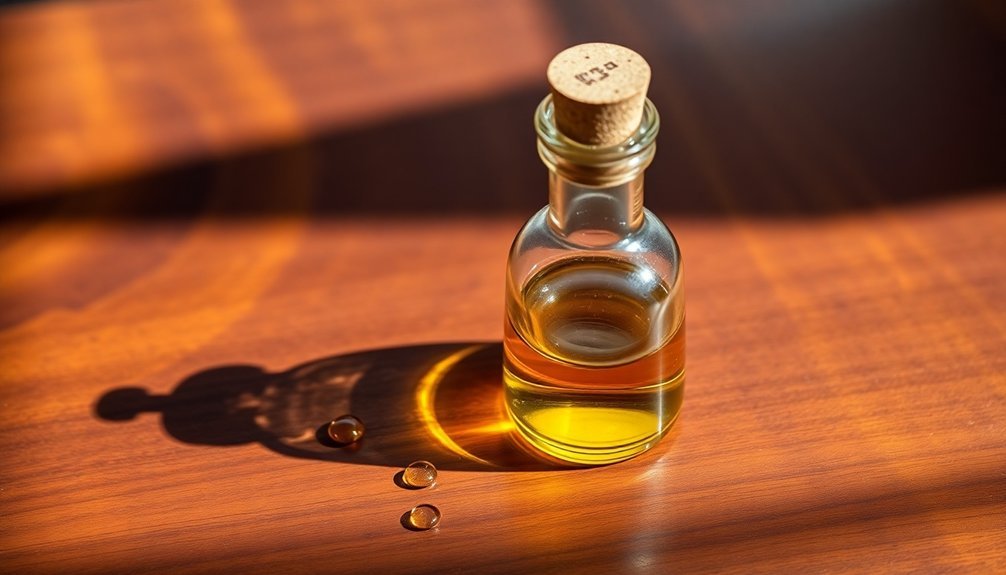
When crafting your signature teakwood scent, you'll want to follow the established oil-to-carrier ratios of 4.63% for fine fragrances and up to 74.66% for room sprays.
For body care applications like lotions and creams, keep your teakwood fragrance concentration at 4.23% or lower to maintain safety standards.
Your candle making ventures can incorporate teakwood at 8-10% fragrance load, ensuring ideal scent throw while maintaining proper burning characteristics.
Teakwood Base Oil Balancing
Since teakwood's robust character can easily overpower other fragrance elements, achieving the perfect balance in your oil ratios requires careful consideration and precise measurements.
You'll want to start with teakwood as your base note, then carefully layer complementary scents that enhance rather than compete with its natural woody aroma.
- Blend teakwood with citrus top notes like bergamot or orange zest to create an initial burst of freshness that gracefully evolves into woody undertones.
- Add middle notes of lavender or green lily at 30-40% of your base ratio to create depth without overwhelming the teakwood.
- Incorporate vetiver or musk to bridge the gap between top and base notes.
- Fine-tune your blend by adjusting ratios gradually until you achieve a harmonious balance where each note plays its distinct role.
Optimal Fragrance Load Percentages
Building on your foundation of balanced teakwood blends, the next step involves determining precise fragrance load percentages for your signature scent.
You'll want to aim for 6-10% fragrance load when working with soy wax, though teakwood scents often perform best at 8-10%.
To calculate your fragrance load, multiply your wax weight by your desired percentage. For instance, if you're using 170g of soy wax at 8%, you'll need 13.6g of fragrance oil.
Use a digital scale for accuracy.
Remember that your wax type and environmental conditions will influence your ideal percentage.
Start with test burns to evaluate scent throw and burning characteristics. You can adjust the load based on results, but always stay within recommended ranges to prevent issues like tunneling or sooting.
Carrier Oil Dilution Guide
As you explore teakwood essential oil blends, understanding proper dilution ratios becomes essential for both safety and effectiveness.
You'll want to start with a 2% dilution ratio, which means adding 2 drops of teakwood essential oil per teaspoon (5ml) of carrier oil for general use. For sensitive skin or facial applications, reduce to a 1% dilution.
- Choose your carrier oil based on skin type and intended use – jojoba works great for facial blends, while sweet almond oil provides excellent moisturizing properties.
- Measure your carrier oil precisely using a dark glass bottle.
- Add teakwood drops according to your chosen dilution ratio.
- Label your blend immediately with ingredients and creation date.
Store your teakwood blend in a cool, dark place and always perform a patch test before full application.
The Art of Layering With Teakwood
When mastering fragrance layering, teakwood offers a sophisticated foundation that can transform your signature scent.
You'll find that teakwood's woody, aromatic profile pairs beautifully with complementary fragrances like vanilla, sandalwood, and citrus notes.
To create your unique blend, you can use direct layering by applying teakwood first, followed by one or two spritzes of your accent perfume.
Alternatively, try mixing on skin by spraying fragrances on separate areas and gently blending them.
For maximum impact, start with a teakwood-scented shower gel, follow with a matching body lotion, and finish with your perfume combination.
You'll enhance longevity by ensuring your skin is well-moisturized before application.
Don't hesitate to experiment with different pairings like tobacco leaf, clove, or leather notes to discover your perfect signature blend.
Natural vs. Synthetic Teakwood Notes
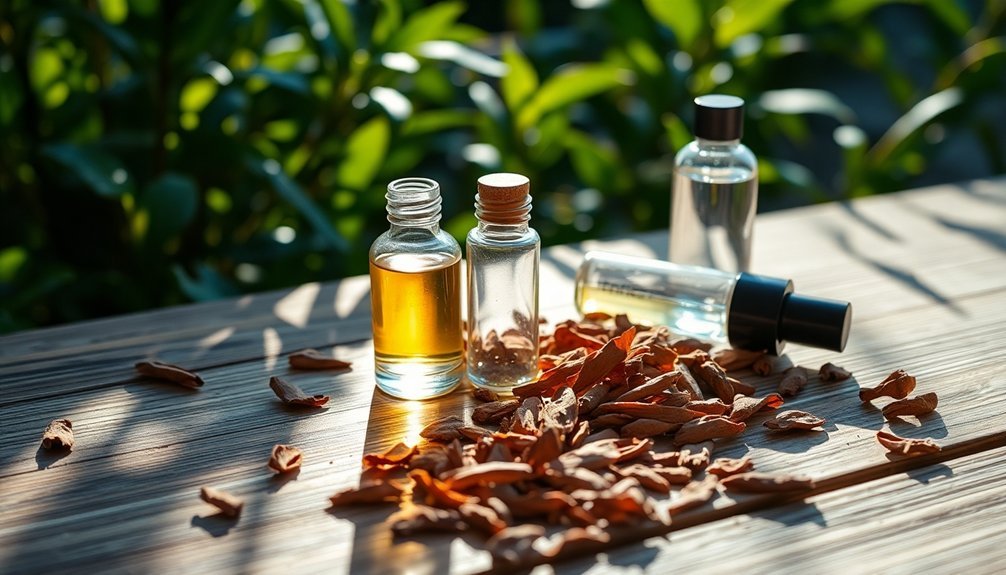
Understanding the difference between natural and synthetic teakwood notes empowers you to make informed choices for your signature scent.
Natural teakwood contains terpenes and flavonoids that create a complex, warm profile with hints of musk, leather, and tobacco. You'll find subtle undertones of citrus, vanilla, and honey that evolve on your skin.
Synthetic alternatives offer a more consistent scent experience, often blending with bergamot, cardamom, and floral notes.
- Natural teakwood promotes focus and relaxation through its authentic aromatic compounds.
- Synthetic versions are typically phthalate-free and safer for sensitive skin.
- You'll get more depth and complexity from natural teakwood notes.
- Synthetic alternatives provide better consistency and compatibility with other fragrance elements in your personal care products.
Achieving Balance in Complex Blends
Creating a balanced teakwood fragrance requires mastering the interplay between core notes and complementary scents.
You'll want to build your blend by carefully layering top, middle, and base notes for a harmonious shift. Start with spicy and floral top notes like allspice and lavender, then incorporate tobacco leaf and clove middle notes for depth.
For the perfect balance, you can pair teakwood's rich woody base with complementary scents like vanilla for warmth, citrus for brightness, or mint for invigorating clarity.
The key is to let each note shine without overpowering the others. When you're crafting your signature scent, remember that teakwood's versatility allows it to work beautifully with both masculine and feminine fragrances, making it an ideal foundation for a unique personal blend.
Temperature and Storage Considerations

To maintain your teakwood fragrance's potency, you'll want to store it between 60°F and 70°F in a cool, dark place away from direct sunlight.
You'll notice the oil's quality deteriorate faster if exposed to temperature fluctuations or bright light, which can alter its chemical composition and diminish its signature woody notes.
Ideal Storage Temperature Range
Proper temperature control stands as the cornerstone of preserving your teakwood fragrance's quality and character.
You'll want to maintain your signature scent between 52 to 57 degrees Fahrenheit, as this range guarantees peak preservation of those rich, woody notes. Keeping your fragrance at a consistent temperature is just as vital as the temperature itself, so avoid environments where temperatures fluctuate dramatically.
- Store your teakwood perfume in a temperature-controlled environment like a wine cooler.
- Don't let temperatures drop below 40 degrees Fahrenheit, as this can quickly degrade the scent.
- Keep your fragrance away from heat sources that could push temperatures above the ideal range.
- Monitor your storage area's temperature regularly to confirm it stays within the peak zone.
Light and Heat Impact
While temperature control plays an essential role in preserving your teakwood fragrance, light exposure and heat management are equally important factors that can make or break your scent's longevity.
UV light can degrade your fragrance oils and alter their color, so you'll want to keep your scent away from windows and direct sunlight. Using amber or dark glass bottles provides essential protection against light-induced changes.
Heat is particularly challenging for teakwood fragrances, as it accelerates chemical reactions that can destabilize the scent profile. High temperatures affect base notes most notably, potentially causing them to become overpowering.
To maintain your fragrance's integrity, store it below its flashpoint (200.3°F) and away from heat sources. Cool, consistent temperatures will help preserve the balance and strength of your signature scent.
Preserving Teakwood Oil Longevity
Since temperature fluctuations can quickly degrade teakwood oil's quality, storing your fragrance in a consistently cool environment between 55-65°F proves vital for maximum longevity.
Just like protecting teak furniture, your teakwood-based fragrance needs proper storage conditions to maintain its rich, complex notes and prevent deterioration.
- Keep your fragrance away from direct sunlight and heat sources, as UV exposure can break down the oil's natural properties.
- Store your scent in a dark, dry place with minimal humidity to prevent moisture from affecting the oil's composition.
- Clean the bottle's exterior regularly and make certain the cap is tightly sealed to maintain the oil's integrity.
- Consider rotating between two bottles if you're in a humid climate, allowing each to rest and stabilize between uses.
Customizing Your Teakwood Signature
Creating your unique teakwood signature scent requires understanding how to blend and layer fragrances effectively.
Start by applying teakwood fragrance to your pulse points, like the nape of your neck and behind your ears, where body heat will naturally diffuse the scent throughout the day.
You'll want to experiment with complementary notes that enhance teakwood's rich profile.
Try pairing it with cedarwood or sandalwood for a deeper woody essence, or add citrus and lavender for a fresher take.
Don't overdo it – a light application will prevent the scent from becoming overwhelming.
Consider seasonal adjustments, using lighter applications in summer and stronger ones in winter.
For a truly personalized blend, you can layer teakwood with spicy notes like allspice or sweeter elements such as vanilla and tonka bean.
Sustainability in Teakwood Sourcing
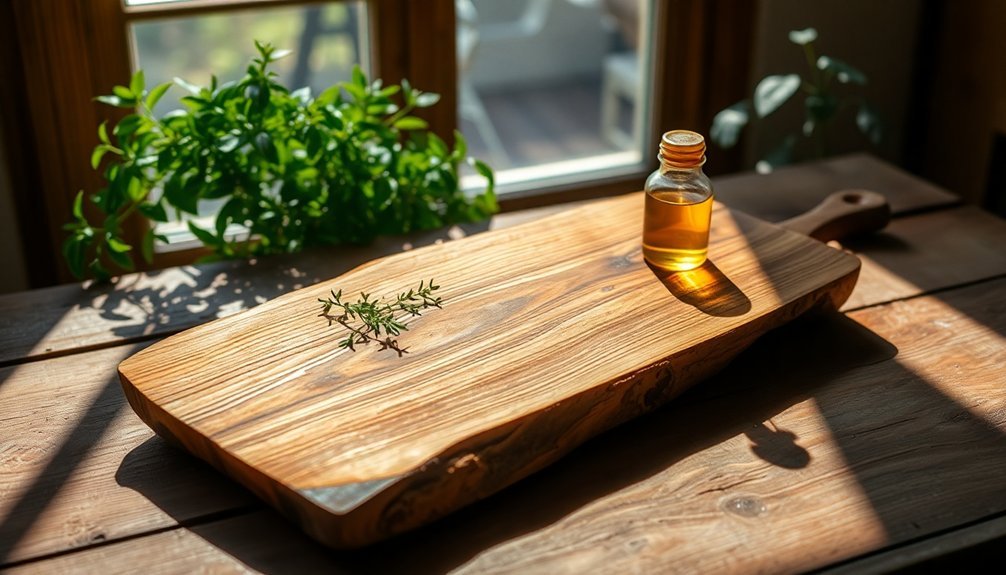
Beyond crafting your perfect scent, understanding where your teakwood comes from guarantees you're making environmentally conscious choices.
When you choose fragrances with sustainably sourced teakwood, you're supporting regulated plantations that protect natural forests and biodiversity. The wood's natural pest resistance means fewer chemicals are needed, while its inherent oils provide protection without artificial treatments.
- Your teakwood comes from government-regulated Indonesian plantations that follow strict harvesting rules and replanting programs.
- FSC and SVLK certifications assure your fragrance ingredients meet rigorous sustainability standards.
- Teakwood's natural properties eliminate the need for harmful chemical treatments.
- The trees act as carbon sinks during growth, contributing to environmental preservation while creating your signature scent.
Frequently Asked Questions
Can Teakwood Fragrance Trigger Allergic Reactions in Sensitive Skin?
Yes, you can experience allergic reactions to teakwood fragrance if you have sensitive skin. It's known to cause skin irritation, redness, and allergic reactions due to compounds like lapachol and deoxylapachol.
How Long Does Teakwood Scent Typically Last on Clothing?
When you spray teakwood directly on your clothing, it'll typically last several hours longer than on skin. You can expect the scent to remain noticeable for 4-8 hours on fabric.
Does Teakwood Fragrance Change Smell When Mixed With Body Chemistry?
Yes, your unique body chemistry will alter teakwood's scent considerably. You'll notice the fragrance can become warmer, earthier, or even develop leather-like notes depending on your skin's natural composition and hormonal balance.
Why Does Teakwood Smell Different in Various Brands' Products?
You'll notice teakwood smells different across brands because they use varying processing methods, blend different complementary fragrances, and source their teakwood from different regions, which all affect the final scent profile.
Can Pregnancy or Medications Affect How Teakwood Scent Is Perceived?
Yes, your pregnancy can dramatically change how you perceive teakwood scents. Hormonal changes often heighten smell sensitivity, while certain medications might alter your scent perception. Both factors can make teakwood smell different to you.
In Summary
Teakwood can work brilliantly in your signature scent because you're leveraging its complex molecular structure and rich aromatic profile. When you've balanced it with complementary top notes and the right base combinations, you'll create a unique fragrance that's distinctly yours. Remember to store your teakwood-based perfume properly and choose sustainably sourced materials to guarantee your signature scent remains both ethical and long-lasting.


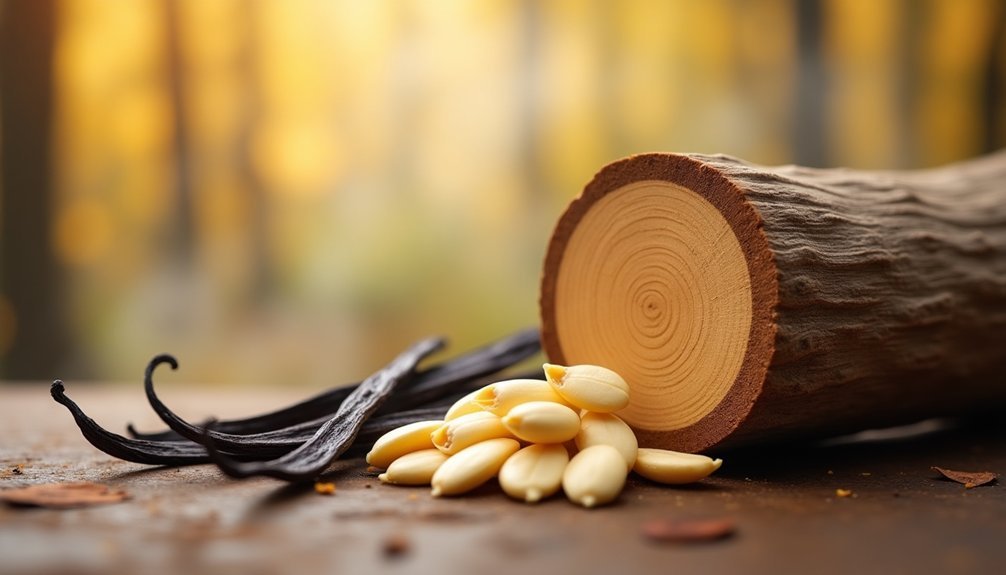
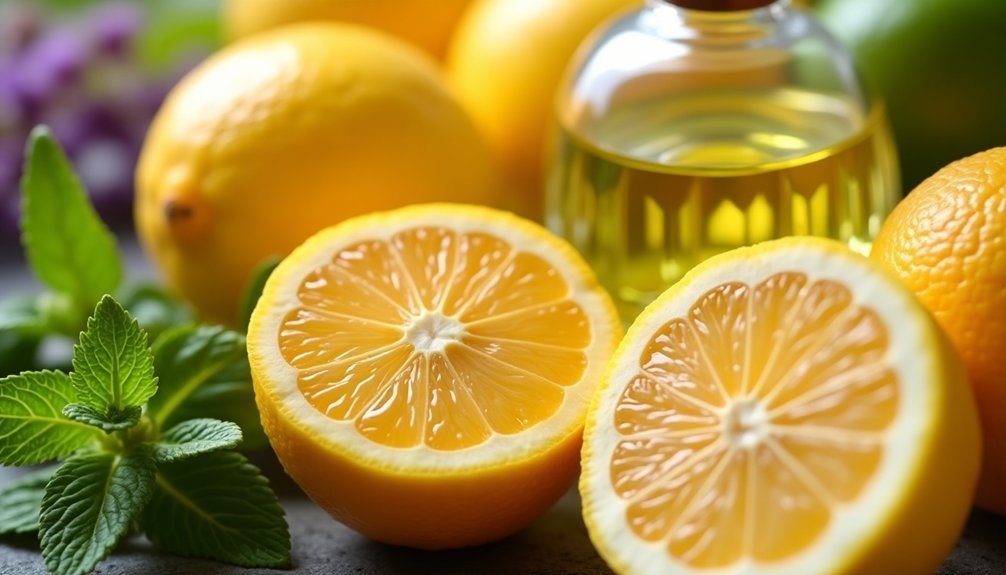
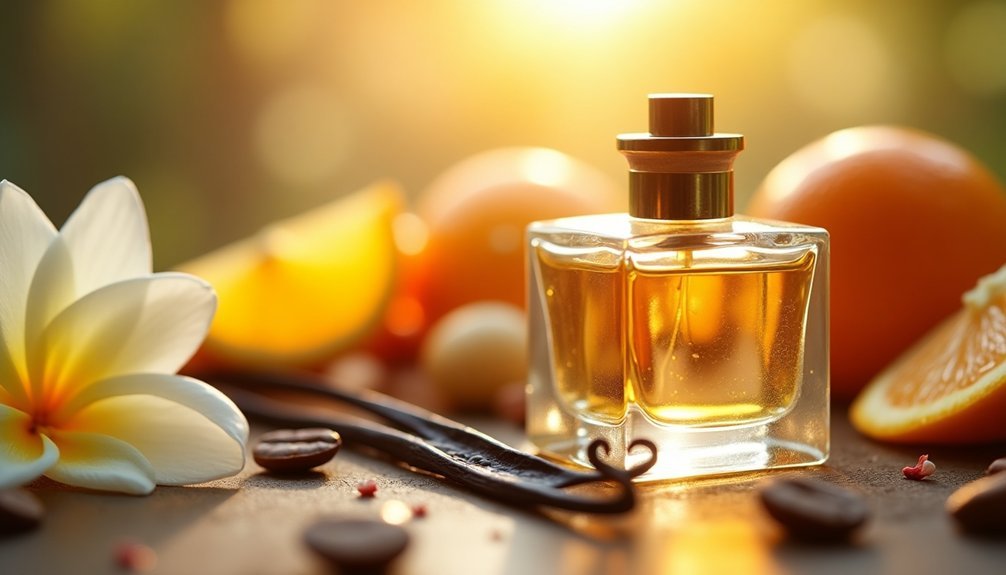
Leave a Reply